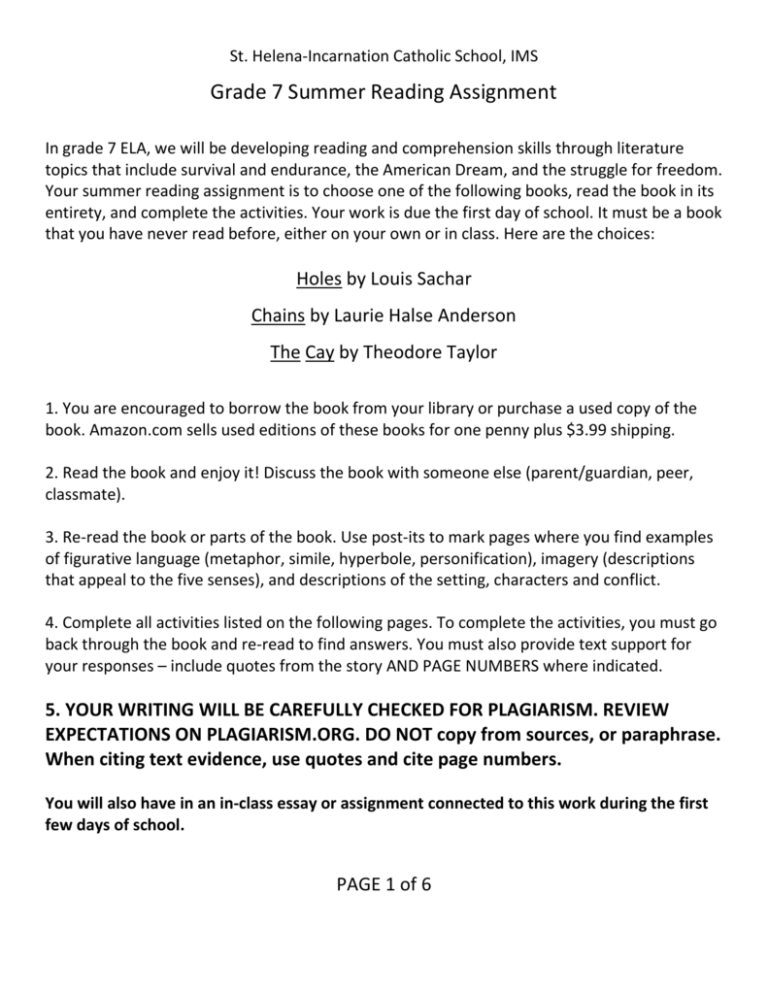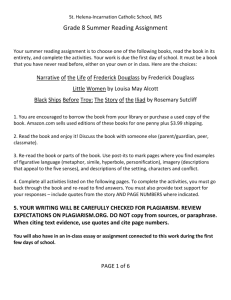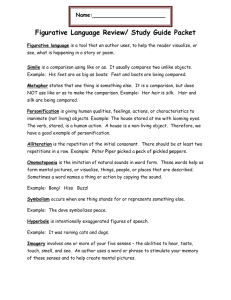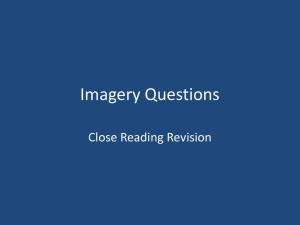2015 Summer Reading Assignment Grade 7
advertisement

St. Helena-Incarnation Catholic School, IMS Grade 7 Summer Reading Assignment In grade 7 ELA, we will be developing reading and comprehension skills through literature topics that include survival and endurance, the American Dream, and the struggle for freedom. Your summer reading assignment is to choose one of the following books, read the book in its entirety, and complete the activities. Your work is due the first day of school. It must be a book that you have never read before, either on your own or in class. Here are the choices: Holes by Louis Sachar Chains by Laurie Halse Anderson The Cay by Theodore Taylor 1. You are encouraged to borrow the book from your library or purchase a used copy of the book. Amazon.com sells used editions of these books for one penny plus $3.99 shipping. 2. Read the book and enjoy it! Discuss the book with someone else (parent/guardian, peer, classmate). 3. Re-read the book or parts of the book. Use post-its to mark pages where you find examples of figurative language (metaphor, simile, hyperbole, personification), imagery (descriptions that appeal to the five senses), and descriptions of the setting, characters and conflict. 4. Complete all activities listed on the following pages. To complete the activities, you must go back through the book and re-read to find answers. You must also provide text support for your responses – include quotes from the story AND PAGE NUMBERS where indicated. 5. YOUR WRITING WILL BE CAREFULLY CHECKED FOR PLAGIARISM. REVIEW EXPECTATIONS ON PLAGIARISM.ORG. DO NOT copy from sources, or paraphrase. When citing text evidence, use quotes and cite page numbers. You will also have in an in-class essay or assignment connected to this work during the first few days of school. PAGE 1 of 6 1. List and define 25 unfamiliar words that you found in the book and the page numbers where the words appear. Use dictionary or dictionary.com. If there are multiple definitions for one word, choose the definition that makes the most sense in the context of the story. Use a separate sheet of paper if necessary. __________________________________________________________________________________________ __________________________________________________________________________________________ __________________________________________________________________________________________ __________________________________________________________________________________________ __________________________________________________________________________________________ __________________________________________________________________________________________ __________________________________________________________________________________________ __________________________________________________________________________________________ __________________________________________________________________________________________ __________________________________________________________________________________________ __________________________________________________________________________________________ __________________________________________________________________________________________ __________________________________________________________________________________________ __________________________________________________________________________________________ __________________________________________________________________________________________ __________________________________________________________________________________________ __________________________________________________________________________________________ __________________________________________________________________________________________ __________________________________________________________________________________________ __________________________________________________________________________________________ __________________________________________________________________________________________ __________________________________________________________________________________________ __________________________________________________________________________________________ __________________________________________________________________________________________ __________________________________________________________________________________________ __________________________________________________________________________________________ __________________________________________________________________________________________ __________________________________________________________________________________________ __________________________________________________________________________________________ PAGE 2 of 6 2. Who is the narrator? _____________________________________________________________________ 3. Who are the characters? Write their names and describe their situations in the novel. __________________________________________________________________________________________ __________________________________________________________________________________________ __________________________________________________________________________________________ __________________________________________________________________________________________ __________________________________________________________________________________________ __________________________________________________________________________________________ 4. What is the setting? Time Period _________________________________________ Place _____________________________________________________________________________________ Describe the setting using details from the story: __________________________________________________________________________________________ __________________________________________________________________________________________ __________________________________________________________________________________________ __________________________________________________________________________________________ __________________________________________________________________________________________ __________________________________________________________________________________________ Page number(s) ____________________ 5. In a well-developed paragraph, summarize the main conflict (problem) in the novel and how it was resolved (solved). Use a separate sheet of paper if necessary. __________________________________________________________________________________________ __________________________________________________________________________________________ __________________________________________________________________________________________ __________________________________________________________________________________________ __________________________________________________________________________________________ __________________________________________________________________________________________ __________________________________________________________________________________________ __________________________________________________________________________________________ __________________________________________________________________________________________ _____________________________________________________________________________ _____________________________________________________________________________ PAGE 3 of 6 6. Put an X next to the type of conflict that you described in question 3. Then support your answer with a quote from the novel and give the page number of the quote. ____ Character vs. nature ____ Character vs. another character(s) ____ Character vs. society ____ Character vs. God or a higher power ____ Character vs. self Text Support: ______________________________________________________________________________ __________________________________________________________________________________________ __________________________________________________________________________________________ __________________________________________________________________________________________ Page Number(s) ____________ 7. What other conflicts can you identify in the story? Include page numbers for text support. __________________________________________________________________________________________ __________________________________________________________________________________________ __________________________________________________________________________________________ __________________________________________________________________________________________ __________________________________________________________________________________________ __________________________________________________________________________________________ __________________________________________________________________________________________ 8. Characterization: Identify three qualities or traits that describe the main character. Then, give an example from the story that shows each character trait. Include the page number. Trait ________________________________________________________ page _______ Text support – Give an example from the story that shows this character trait: __________________________________________________________________________________________ __________________________________________________________________________________________ __________________________________________________________________________________________ Trait ________________________________________________________ page _______ Text support – Give an example from the story that shows this character trait: __________________________________________________________________________________________ __________________________________________________________________________________________ __________________________________________________________________________________________ Trait ________________________________________________________ page _______ Text support – Give an example from the story that shows this character trait: __________________________________________________________________________________________ __________________________________________________________________________________________ __________________________________________________________________________________________ __________________________________________________________________________________________ PAGE 4 OF 6 9. Identify the main character’s goal, or what the character wants to do in this novel. Provide text support. ___________________________________________________________________________________ ___________________________________________________________________________________ ___________________________________________________________________________________ My answer is based on page ____________________ in the story. 10. On a separate sheet of paper, illustrate your character according to the author’s physical description and your own visualization. On the same paper, list quotes from the story that helped you imagine what the character looked like. Use pencils, crayons, markers, or colored pencils. 11. Figurative Language: Imagery Imagery is when an author describes something so vividly that you can imagine how it looks, sounds, tastes, smells, or feels like physically. Imagery enables you to imagine what the author is describing using one or more of your five senses. In your book, find an example of imagery that appeals to your sense of sight – something that is described with details that enable you to clearly imagine what it looks like. Include the full example and page number. __________________________________________________________________________________________ __________________________________________________________________________________________ __________________________________________________________________________________________ Page number: ________________ 12. Find an example of imagery that appeals to your sense of hearing – a description of how something sounds. Include the full example and the page number. __________________________________________________________________________________________ __________________________________________________________________________________________ __________________________________________________________________________________________ Page number: ________________ 13. Find an example of imagery that appeals to your sense of taste – a description of what something tastes like. Include the full example and the page number. __________________________________________________________________________________________ __________________________________________________________________________________________ __________________________________________________________________________________________ Page number: ________________ 14. Find an example of imagery that appeals to your sense of touch - what something feels like physically (soft, rough, smooth, etc.). Include the full example and the page number. __________________________________________________________________________________________ __________________________________________________________________________________________ __________________________________________________________________________________________ Page number: ________________ PAGE 5 OF 6 15. Find an example of imagery that appeals to your sense of smell. Include the full example and the page number. __________________________________________________________________________________________ __________________________________________________________________________________________ __________________________________________________________________________________________ Page number: ________________ 16. A simile is a comparison using “like” or “as” (examples: sings like a bird; as cold as ice). Identify a simile in your book. Include the page number. __________________________________________________________________________________________ __________________________________________________________________________________________ Page number: ________________ 17. A metaphor is a comparison WITHOUT using “like” or “as” (for example: friendship is a treasure; Sara is an angel). Identify a metaphor in your book. Include the page number. __________________________________________________________________________________________ __________________________________________________________________________________________ Page number: ________________ 18. Personification is when an author gives human traits and qualities to a non-human living thing, inanimate object, or idea (for example, the tea kettle sang). Identify an example of personification in your book. Include the page number. __________________________________________________________________________________________ __________________________________________________________________________________________ Page number: ________________ 19. Hyperbole is an extreme exaggeration (For example: I worked 100 hours today; He never stops talking). Identify an example of hyperbole in the story. Include the page number. __________________________________________________________________________________________ __________________________________________________________________________________________ Page number: ________________ 20. A theme is the lesson, or moral, of the story. It MUST BE A COMPLETE STATEMENT, not just a word or phrase. For example: Hard work has its rewards; Money can’t buy everything. What is the theme of your book? Use at least one example from the book to explain why this is the theme. __________________________________________________________________________________________ __________________________________________________________________________________________ __________________________________________________________________________________________ __________________________________________________________________________________________ PAGE 6 OF 6 Common Core ELA Standards Addressed: Literacy.RL.7.1 – Cite several pieces of textual evidence to support analysis of what the test says explicitly as well as inferences drawn from the text. Literacy.RL.7.2 – Determine a theme or central idea of a text and analyze its development over the course of the text; provide an objective summary of the text. Literacy.RL.7.3 – Analyze how particular elements of a story or drama interact (e.g., how setting shapes the characters or plot). Literacy RL.7.4 – Determine the meaning of words and phrases as they are used in a text, including figurative and connotative meanings.






